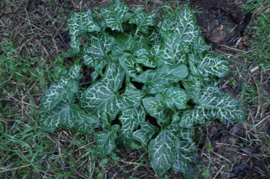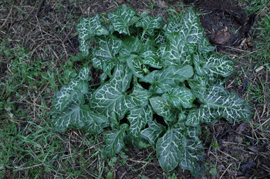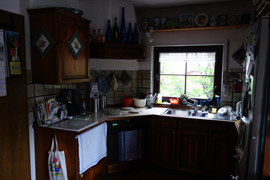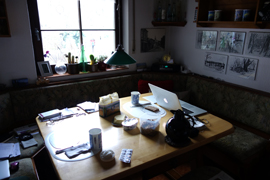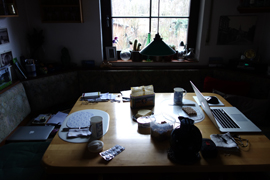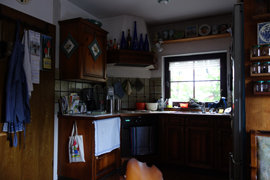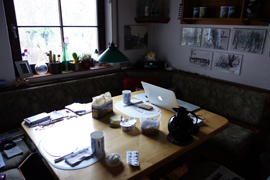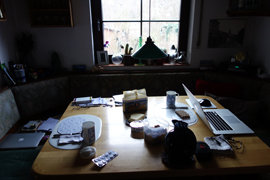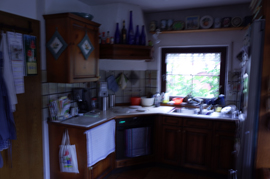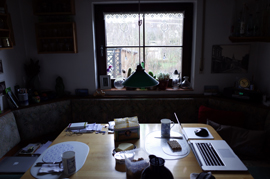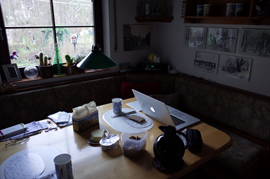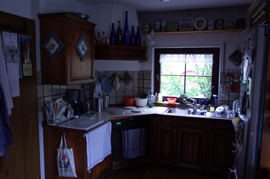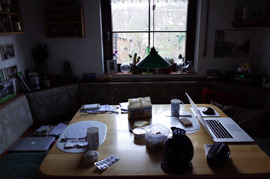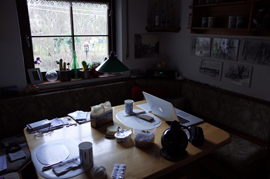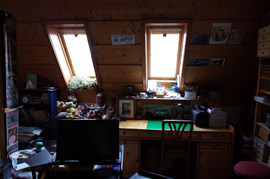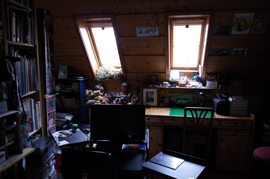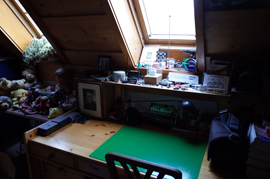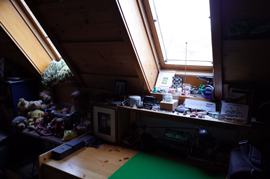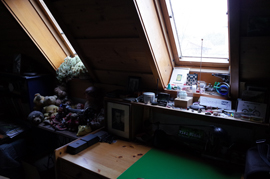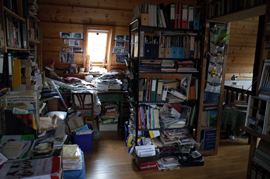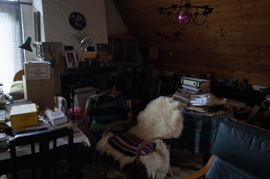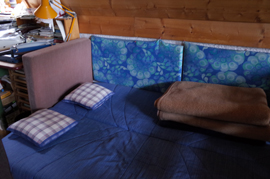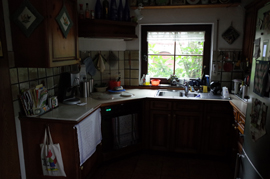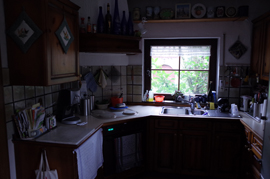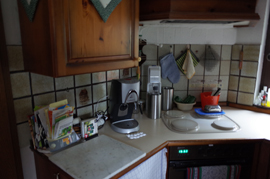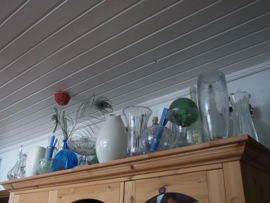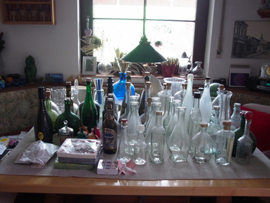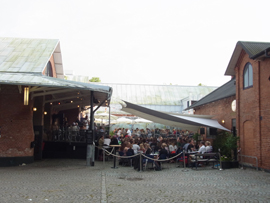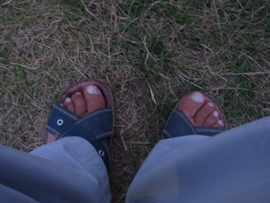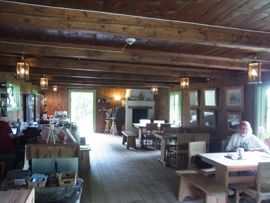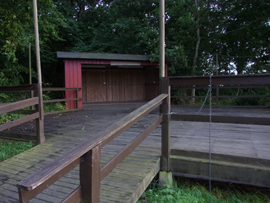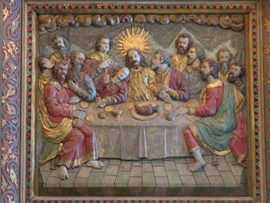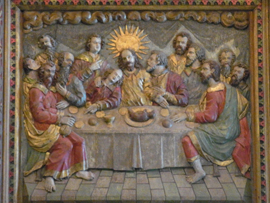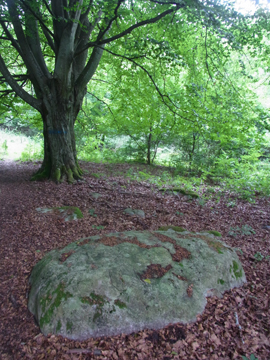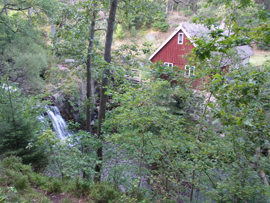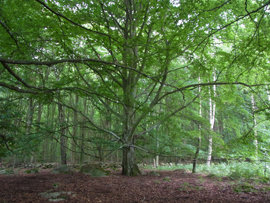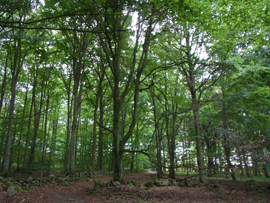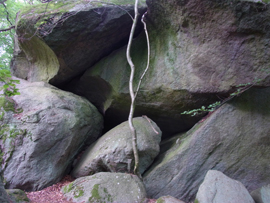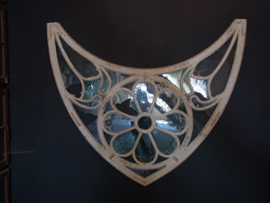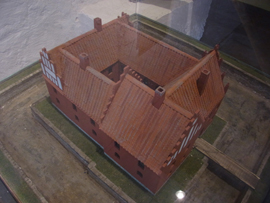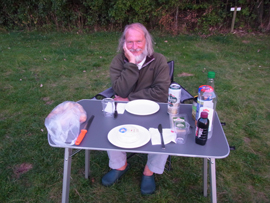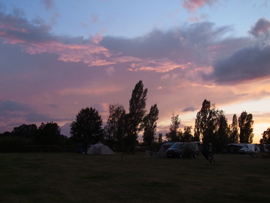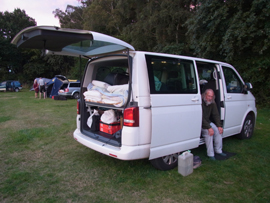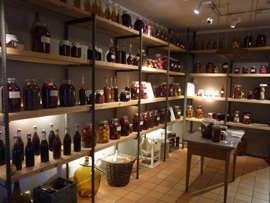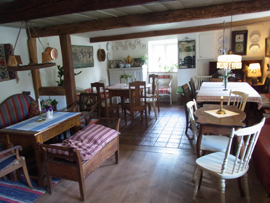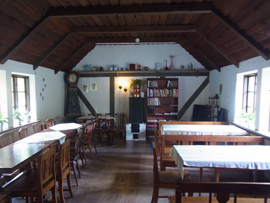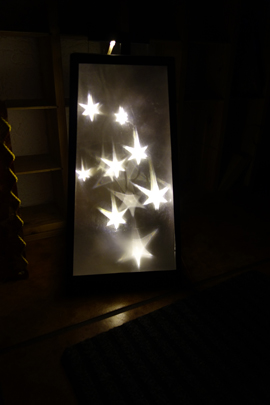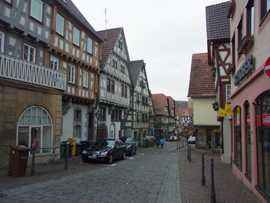General: Physical Limits of Photography: Insufficient Light - Part 4
Part 1 | Part 2 | Part 3 | Part 4 | Part 5 | Part 6 | Part 7
How Much Light Is Available? The Exposure Value as a Guide | Exposure Value Examples - Introduction | Exposure Value Examples - Part 1 | Exposure Value Examples - Part 2 | References
In this series of articles, I will describe an example of where photography is reaching the limits of physics, namely, when light is scarce. Many photographers expect even in this case that their camera delivers perfect photos. In this series, I will try to explain why this is not possible. And I would also like to address the differences between large and small sensors, because I have the impression that many owners of compact cameras expect too much from their small-sensor cameras, among others, because they ignore or do not know what the difference implies.
The first part in the series serves as an introduction to the topic, asks for reasons for unsatisfactory, particularly blurry, photos, and discusses possible "countermeasures". In the second and third parts, which are supplemented by additional pages with test images, I compare cameras with sensors of different sizes with respect to their performance at different ISO values. In this fourth part, I present the concept of an "exposure value" (EV) as a measure of the amount of light that is available for a photo and present sample photos for illustration. In the fifth and sixth parts, I present examples of situations in which only little light is available. For illustration, I provide the exposure values and other photographic data. In the seventh and last part, I try to summarize the results.
How Much Light Is Available? The Exposure Value as a Guide
If you are talking about low light conditions, it makes sense to provide some clues what this really means. The easiest way to do so is to consider exposure values (EV). An EV is a range of aperture and shutter combinations that describe the same amount of light. Perhaps you may be able to remember that an exposure value of 0 represents an exposure time of 1 second at an aperture of f/1. An EV 1 means 1 second at f/1.4 or 1/2 sec at f/1, and so on. EVs are typically shown in charts or tables. Such a table, but slightly modified, is shown further below.
From the exposure value you cannot determine the actual brightness. The light sensitivity, expressed as ISO values, must also be known for an exposure value that represents the correct exposure. Normally, EV 0 with 1 second at f/1 leads to a correct exposure for ISO 100.
There is second definition of exposure value in which the ISO value is divided by 100 in the respective formula (see the references for details). For ISO 100, both definitions are thus identical. Older light meters typically used an ISO-dependent definition of exposure value, because this facilitates the transmission of the shutter speed / aperture combination to the camera. Digital cameras list the exposure value in the EXIF data, and I have found that all my cameras use the ISO-independent (or ISO 100) definition of exposure value. This means in practice that, at the same exposure value, I get different shutter speed / aperture combinations for different ISO values, but brightness, given as EV value, is identical (apart from minor technical differences...). This is reflected by the fact that identical photos that were taken with different ISO values look (more or less) equally lighted, although some of them may look fuzzy because of long shutter speeds.
How Do Cameras Handle the Exposure Value?
I have checked for four of our cameras, whether the exposure value is used according to the ISO-independent definition and as such stored in the Exif data.
My first two series of test shots examined only the behavior of the cameras as it can be observed in the viewfinder (the exposure value is not displayed there). I first varied the ISO value, and measured shutter speed and aperture value (for this, I briefly pressed the shutter button half-way). In another series of test shots, I fixed the ISO value and varied the exposure compensation in positive and negative directions. In both tests, shutter speeds changed in the same, expected manner for all cameras (the aperture was completely open). Only at low light levels, it may have come to deviations. The Ricoh cameras, at least, appear to adjust EV values below a level of EV 6 and reduce the change in exposure value. The reasons for this are not known to me (see below). This is possibly why I obtained inconsistent results with respect to the "real" light sensitivity, when I used exposure compensation in the field (as far as I can tell in retrospect...).
To determine which value the cameras save in the Exif data, I made two more series of experiments with the Leica Vario X, hoping that other cameras behave similarly (I did a "quick test" of exposure compensation for the Ricoh CX4, too, and its results correspond to those of the X Vario test). When varying the ISO values, I obtained only very low exposure value deviations, even though I took the pictures by hand. Only at ISO 6400 and ISO 12500, the EV fell slightly (from 2.9 to 2.5 and 2.6). The result of this test is that cameras indeed use the exposure value according to the ISO-independent definition and store it in this format in the Exif data (some of the example photos below verify this as well).
In a second series of photos, I varied the exposure compensation and kept the ISO value fixed at ISO 3200. Again, the exposure values were fairly stable, but it turned out that the exposure compensation is "included" in the exposure values in the Exif data, so that the exposure values now differed depending on the respective exposure compensation levels:
- EV -3: 5.6 (=> 2.6)
- EV -2: 4.5 (=> 2.5)
- EV -1: 3.5 /=> 2.5)
- EV 0: 2.5 / 2.5 / 2.5 (=> 2.5)
- EV +0.3: 2.3 (=> 2.6)
- EV +1: 1.6 / 1.6 / 1.6 (=> 2.6)
- EV +1.7: 0.9 (=> 2.6)
- EV +2: 0.6 / 0.6 (=> 2.6)
- EV +3: -0.4 (=> 2.6)
Note: For simplicity reasons, I measured some of the values several times - and once I turned the bracketing function accidentally on (+/- EV 0.7)... Overall, the exposure values in this test are, despite shooting by hand, quite consistent.
The second test series shows that cameras, when they save the exposure value in the Exif data, include a potential exposure compensation in the saved exposure value. To retrieve the "real" exposure value, you have to add up exposure value and exposure compensation with the correct sign (see the list above). I have not done this in the many example photos for this topic (and will not do so). However, the manufacturer's data regarding the exposure link ranges of cameras show that this rule may not apply to low light levels - my own experiments suggest that at least in part.
Exposure value information can be found, for example, in the technical data for cameras to describe the measurement range of the metering system or the behavior of the automatic exposure system (see below).
Exposure (Link) Range for Some of Our Cameras
- CX4 (f/3.5-5.6): Wide: 3.2 – 16.2 EV; Tele: 4.6 – 18.4
EV (ISO 100)
Note: At 6.0 EV or lower, each drop of 1.0 EV is associated with a 0.5 EV??? drop in brightness. Brightness drops by no more than 1.0 EV. - GXR P10 (f/3.5-5.6): Wide: 3.2 – 16.2 EV; Tele: 4.6 – 18.4
EV (ISO 100)
Note: At 6.0 EV or lower, each drop of 1.0 EV is associated with a 0.25 EV drop in brightness. Brightness drops by no more than 1.0 EV. - GXR A12-50/A12-28 (f/2.5): 2.2 – 19.3 EV (ISO 100)
Note: At 6.0 EV or lower, each drop of 1.0 EV is associated with a 0.25 EV drop in brightness. Brightness drops by no more than 1.0 EV. - GXR A16 (f/3.5-5.5) Wide: 3.2 – 16.8 EV; Tele: 3.6 – 18.1
EV ISO 100)
Note: At 6.0 EV or lower, each drop of 1.0 EV is associated with a 0.25 EV drop in brightness. Brightness drops by no more than 1.0 EV. - GXR M-Mount expansion unit (at f/2.5): 1.2 – 13.3 EV (ISO 100)
- GR (f/2.8): 1.8 – 17.8 EV (ISO 100)
Table of Exposure Values
The following table use the ISO-independent EV definition and should help you get an idea of what exposure times are obtained at different ISO values under low light conditions, when an aperture value of f/2.8 or f/5.6 is selected. These values corresponds roughly to a zoom camera in wide angle and tele photo position (many cameras, for example, my Leica X Vario, do not even offer these aperture values and allow only less favorable exposure times). I present the exposure time of 1/30 s in boldface to highlight the longest exposure time that can typically be hand-held. Even longer exposure times are printed in red.
| ISO | Table for Aperture:
2.8 |
Table for
Aperture: 5.6 |
|||||||||||||||||||
Exposure Value (EV) |
Exposure Value
(EV) |
||||||||||||||||||||
0 |
1 |
2 |
3 |
4 |
5 |
6 |
7 |
8 |
0 |
1 |
2 |
3 |
4 |
5 |
6 |
7 |
8 |
9 |
10 |
||
Exposure Time (Shutter
Speed) |
Exposure Time (Shutter
Speed) |
||||||||||||||||||||
| 100 | 8 | 4 | 2 | 1 | 1/2 | 1/4 | 1/8 | 1/15 | 1/30 | 32 | 16 | 8 | 4 | 2 | 1 | 1/2 | 1/4 | 1/8 | 1/15 | 1/30 | |
| 200 | 4 | 2 | 1 | 1/2 | 1/4 | 1/8 | 1/15 | 1/30 | 1/60 | 16 | 8 | 4 | 2 | 1 | 1/2 | 1/4 | 1/8 | 1/15 | 1/30 | 1/60 | |
| 400 | 2 | 1 | 1/2 | 1/4 | 1/8 | 1/15 | 1/30 | 1/60 | 1/125 | 8 | 4 | 2 | 1 | 1/2 | 1/4 | 1/8 | 1/15 | 1/30 | 1/60 | 1/125 | |
| 800 | 1 | 1/2 | 1/4 | 1/8 | 1/15 | 1/30 | 1/60 | 1/125 | 1/250 | 4 | 2 | 1 | 1/2 | 1/4 | 1/8 | 1/15 | 1/30 | 1/60 | 1/125 | 1/250 | |
| 1600 | 1/2 | 1/4 | 1/8 | 1/15 | 1/30 | 1/60 | 1/125 | 1/250 | 1/500 | 2 | 1 | 1/2 | 1/4 | 1/8 | 1/15 | 1/30 | 1/60 | 1/125 | 1/250 | 1/500 | |
| 3200 | 1/4 | 1/8 | 1/15 | 1/30 | 1/60 | 1/125 | 1/250 | 1/500 | 1/1000 | 1 | 1/2 | 1/4 | 1/8 | 1/15 | 1/30 | 1/60 | 1/125 | 1/250 | 1/500 | 1/1000 | |
| 6400 | 1/8 | 1/15 | 1/30 | 1/60 | 1/125 | 1/250 | 1/500 | 1/1000 | 1/2000 | 1/2 | 1/4 | 1/8 | 1/15 | 1/30 | 1/60 | 1/125 | 1/250 | 1/500 | 1/1000 | 1/2000 | |
| 12800 | 1/15 | 1/30 | 1/60 | 1/125 | 1/250 | 1/500 | 1/1000 | 1/2000 | 1/4000 | 1/4 | 1/8 | 1/15 | 1/30 | 1/60 | 1/125 | 1/250 | 1/500 | 1/1000 | 1/2000 | 1/4000 | |
| 25600 | 1/30 | 1/60 | 1/125 | 1/250 | 1/500 | 1/1000 | 1/2000 | 1/4000 | 1/8000 | 1/8 | 1/15 | 1/30 | 1/60 | 1/125 | 1/250 | 1/500 | 1/1000 | 1/2000 | 1/4000 | 1/8000 | |
As an example, the table shows: At an aperture value of f/2.8, an EV 3 corresponds to an exposure time of 1 second at ISO 100 and of 1/30 s at ISO 3200. For an aperture value of f/5.6, you already need an exposure time of 1/8 s for exposing the photo correctly.
For achieving a good image quality, an ISO value of 3200 is a little too high for my own cameras - except for Web images (see my demonstrations below and on the following pages). Motives with a brightness around EV 3 therefore already present a "limiting case" (or a challenge...) for my cameras, and I have to brood on how I can achieve an acceptable photo under those conditions without having to use the flash.
Examples of Exposure Values
The following table of exposure values (EV; ISO 100) and lighting conditions is intended to serve as a guide for learning in which photographic situations which exposure values can be expected. This is, of course, only a very coarse guide. Personally, I am particularly interested in low-light situations.
| EV | Lighting Condition | |||
| 0 | New moon at night (about) | |||
| 1 | ||||
| 2 | Distant views of lighted buildings | |||
| 3 | Floodlit buildings, monuments, and fountains | |||
| 4 | Christmas tree lights | |||
| 5 | Home interiors | |||
| 6 | ||||
| 7 | Offices and work areas | |||
| 8 | Sports events, stage shows, and the like | |||
| 9 | ||||
| 10 | ||||
| 11 | ||||
| 12 | Typical scene, heavily overcast (dull day) / Areas in open shade, clear sunlight otherwise (e.g. north side of a building) | |||
| 13 | Typical scene, cloudy bright (no shadows) | |||
| 14 | Typical scene in hazy sunlight (soft shadows) | |||
| 15 | Typical scene in full or slightly hazy sunlight (distinct shadows) | |||
Source: Wikipedia: Exposure Value (en.wikipedia.org/wiki/Exposure_value)
Exposure Value Examples - Introduction
In the not so recent past, external exposure meters measured brightness (or the amount of available light) in the form of an exposure value (EV). Using movable scales, you selected the appropriate exposure time / aperture combination and transferred it to the camera (the film's light sensitivity had to be set before the measurement). I once owned the Braun Paxette Reflex camera, which allowed to transfer the EV that the built-in selenium light meter had measured onto a "coupled" shutter speed / aperture ring, which then was turned to set the desired shutter speed / aperture combination.
This principle has, however, not prevailed, and I can imagine that the indication of an EV does not mean anything for many photographers. Therefore, I would like to present some photos in the following and specify the EV that the camera measured, as well as shutter speed, aperture, and ISO value. As I indicated above, digital cameras seem to use an exposure value definition that is independent of the ISO value (but the numbers are based on ISO 100) . Therefore, identical samples should look more or less identically lighted irrespective of the ISO value. But they may look fuzzy if the exposure time was too long for hand-held shots, and they may show noise and processing artifacts when high ISO values are used.
In Exposure Value Examples - Part 1, I vary the lighting situations more systematically, including the ISO values, and present mostly "low light" scenes (EV 6.5 and below). In Exposure Value Examples - Part 2, I present a "wild" collection of photos and indicate the exposure data, ISO values, and EVs.
Exposure Value Examples - Part 1
Note: In all the examples in Part 1 no exposure compensation was used.
Same Outdoor Motive - Various ISO Values
The following photos show the same motive under nearly identical lighting conditions (that is, EV as measured by the camera), while the ISO value was varied (click the images for larger versions).
EV 4.3 to 4.6 (Ricoh GR)
EV 4.6: 0.3 s, f/2.8, ISO 100 (fuzzy) |
EV 4.6: 1/6 s, f/2.8, ISO 200 |
EV 4.3: 1/10 s, f/2.8, ISO 400 |
At around EV 4.5, exposure times are already fairly long. Even at ISO 1600, I got just 1/40 s. For each photo, there exists a second version that was fuzzy (or more fuzzy), indicating that the Ricoh GR was at its limit here. Here you can also see that the camera list the same (or a similar) exposure value for different ISO values. |
||
EV 4.3: 1/20 s, f/2.8, ISO 800 |
EV 4.3: 1/40 s, f/2.8, ISO 1600 |
Same Indoor Motive - Various ISO Values
The following photos show the same motive under nearly identical lighting conditions (that is, EV as measured by the camera), while the ISO value was varied (click the images for larger versions).
EV 4.8 to 5 (Ricoh GR)
EV 5: 1/4 s, f/2.8, ISO 100 (fuzzy) |
EV 5: 1/8 s, f/2.8, ISO 200 (fuzzy) |
EV 4.9: 1/15 s, f/2.8, ISO 400 (fuzzy) |
At around EV 5, exposure times are still fairly long. Even at ISO 1600, I got just 1/45 s, however, the camera close aperture a little bit there. For most photos, there exists a second version that was fuzzy (or more fuzzy), indicating that the Ricoh GR was at its limit here. Here you can also see that the camera list the same (or a similar) exposure value for different ISO values. |
||
EV 4.9: 1/30 s, f/2.8, ISO 800 |
EV 4.8: 1/45 s, f/3.2, ISO 1600 |
Different Kitchen Motives - Low EVs (ISO 100 and 200)
Click the images for larger versions!
Sony RX100 M1
| EV 3.7 | EV 5 | EV 5.6 to 6 |
EV 3.7: 1/8 s, f/1.8, ISO 200 |
EV 5: 1/10 s, f/1.8, ISO 100 |
EV 6: 1/20 s, f/1.8, ISO 100 |
EV 3.7: 1/8 s, f/1.8, ISO 200 |
EV 5: 1/20 s, f/1.8, ISO 200 |
EV 5.6: 1/30 s, f/1.8, ISO 200 |
In our dark kitchen in winter, I found EV values between nearly 4 and 6. With f/1.8 and ISO 200, I achieved shutter speeds between 1/8 s and 1/30 s. When raising ISO to higher values, I would achieve shutter speeds between 1/30 s and 1/125 s for ISO 800, and between 1/60 s and 1/250 s for ISO 1600. Note that this is only possible thanks to the Sony RX100's f/1.8 aperture at the wide end.
Here you can also see that the camera list the same (or a similar) exposure value for different ISO values.
Ricoh GR
I took similar photos with the Ricoh GR (the lighting conditions were a little bit better), which show that it is about one EV step worse than the Sony RX100 (because of its maximum aperture value of f/2.8).
| EV 4 | EV 6.3 | EV 6.3 |
EV 4: 1/2 s, f/2.8, ISO 100 (fuzzy) |
EV 6.3: 1/10 s, f/2.8, ISO 100 |
EV 6.3: 1/10 s, f/2.8, ISO 100 |
EV 4: 1/4 s, f/2.8, ISO 200 |
EV 6.3: 1/20 s, f/2.8, ISO 200 |
EV 6.3: 1/20 s, f/2.8, ISO 200 |
The Ricoh CX4 and the Leica X Vario would be even 1.5 stops worse than the Sony RX100 (maximum aperture value of f/3.5). Here you can also see that the camera list the same (or a similar) exposure value for different ISO values.
Different Indoor Motives - Low EVs (ISO 100, 200, and 1600)
Click the images for larger versions!
Ricoh GR
EV 5.3: 1/5 s, f/2.8, ISO 100 (fuzzy) |
EV 5: 1/8 s, f/2.8, ISO 200 |
EV 5.3: 1/60 s, f/3.2, ISO 1600 |
EV 6: 1/8 s, f/2.8, ISO 100 |
EV 6.3: 1/20 s, f/2.8, ISO 200
(fuzzy) |
EV 6.5: 1/90 s, f/4, ISO 1600 |
These motives range between EV 5 and EV 6.5. For ISO 1600, I achieved shutter speeds of 1/60 s and shorter. Moreover, the camera started to close aperture a little (P mode). Here you can also see that the camera list the same (or a similar) exposure value for different ISO values.
Indoor Motives - Very Low EVs (ISO 800 and 1600)
Click the images for larger versions!
Ricoh GR
EV 3.3: 1/20 s, f/2.8, ISO 1600 (nearly sharp) |
EV 2: 1/8 s, f/2.8, ISO 1600 (fuzzy) |
EV 1.3: 1/5 s, f/2.8, ISO 1600 (fuzzy) |
EV 2.9: 1/15 s, f/2.8, ISO 1600
(fuzzy) |
EV 3: 1/8 s, f/2.8, ISO 800 (fuzzy) |
EV 1.3: 0.4 s, f/4, ISO 800 (fuzzy) |
These motives are between 1.3 EV and EV 3.3. Only the shot with EV 3.3 is almost sharp, all the others are fuzzy. Here the camera is clearly at its limits!
Exposure Value Examples - Part 2
The following photo collection is a "wild" blend of photos, focusing on lower light scenes (below EV 12) and including blurry photos. It is primarily about giving an impression of which EVs occur in which situations and what shutter speed/aperture combinations are obtained at certain ISO values. I do not consider this collection as "final" ... All the pictures but one were taken with the Ricoh CX4. If exposure compensation was used, it is given.
EV 4.6: 0.3 s, f/4, ISO 200 (fuzzy) |
EV 6.5: 1/10 s, f/4,2, ISO 200 |
EV 10.6: 1/97 s, f/4, ISO 100 |
EV 5.5: 1/5 s, f/4.3, ISO 200 (fuzzy) |
EV 5.5: 1/10 s, f/4.3, ISO 400 |
EV 3.1: 1 s, f/4.2, ISO 200 (fuzzy) |
EV 5.2: 1/6 s, f/3.5, ISO 200 (fuzzy) |
EV 9.4: 1/42 s, f/4, ISO 100, EV -0,3 |
EV 10: 1/84 s, f/3.5, ISO 100, EV -2 |
EV 5.3: 1/6 s, f/5.1, ISO 400 (fuzzy) |
EV 5.2: 1/11 s, f/5.1, ISO 800 (fuzzy) |
EV 5.1: 1/21 s, f/5.1, ISO 1600 (fuzzy) |
EV 6.1: 1/10 s, f/3.7, ISO 200, EV -0.3 |
EV 7: 1/21 s, f/3.5, ISO 200, EV -0.7 |
EV 8.6: 1/32 s, f/3.5, ISO 100, EV -0.7 |
EV 6.5: 1/15 s, f/3.5, ISO 200, EV -1 |
EV 7.3: 1/26 s, f/3.5, ISO 200, EV -1 |
EV 6.7: 1/17 s, f/3.5, ISO 200, EV -1 |
EV 9.5: 1/60 s, f/3.5, ISO 100, EV -0.7 |
EV 5.6: 1/7 s, f/3.7, ISO 200, EV -0.7 |
EV 7.6: 1/32 s, f/3.5, ISO 200, EV -1.3 |
EV 7.4: 1/24 s, f/3.7, ISO 200, EV -0.7 |
EV 10.8: 1/111 s, f/4, ISO 200, EV -0.7 |
EV 7.6: 1/32 s, f/3.5, ISO 200, EV -0.7 |
EV 4.8: 1/9 s, f/3.5, ISO400 |
EV 5.4: 1/7 s, f/3.5, ISO 200 (fuzzy) |
EV 5.6: 1/8 s, f/3.5, ISO 200 |
EV 4.2: 0.3 s, f/3.5, ISO 200, EV -0.7 (fuzzy) |
EV 3.6: 1/2 s, f/3.5, ISO 200, EV -0.7 (fuzzy) | EV 4.6: 1/30 s, f/1.8, ISO 400 (Sony RX100) |
EV 11.5: 1/233 s, f/3.5, ISO 100 |
References
- Elmar Baumann: Lichtwert, Lichtwert-Diagramm (www.elmar-baumann.de/fotografie/fragen/lichtwert.html) (in German)
- Wikipedia: Lichtwert (de.wikipedia.org/wiki/Lichtwert) (in German)
- Wikipedia: Exposure Value (en.wikipedia.org/wiki/Exposure_value)
Examples and Comparisons on this Website
The following pages show ISO comparisons within individual cameras or GXR camera units and between GXR camera units:
- ISO Comparisons for P10 Camera Unit (Ricoh GXR P10: 1/2.3" sensor)
- ISO Comparisons A12-50, S10, P10 (Ricoh GXR A12-50: APS-C, 1/1.7", and 1/2.3" sensor)
- Daylight Samples A12-28 (Ricoh GXR A12-28: APS-C sensor)
- ISO Comparisons (Ricoh GXR A16: APS-C sensor)
- ISO Samples - Candle Light (Ricoh GR: APS-C sensor)
- ISO Samples - Day Light (Ricoh GR: APS-C sensor)
| 19.11.2021 |
